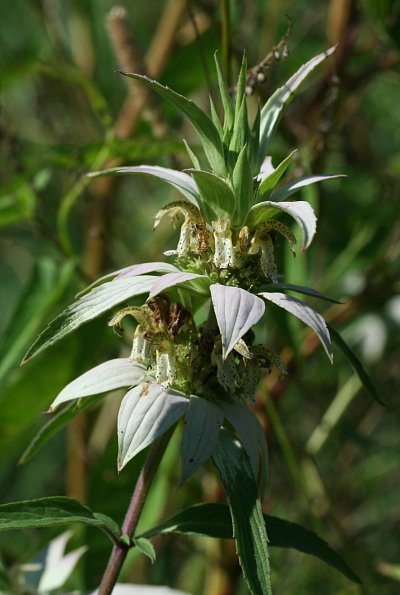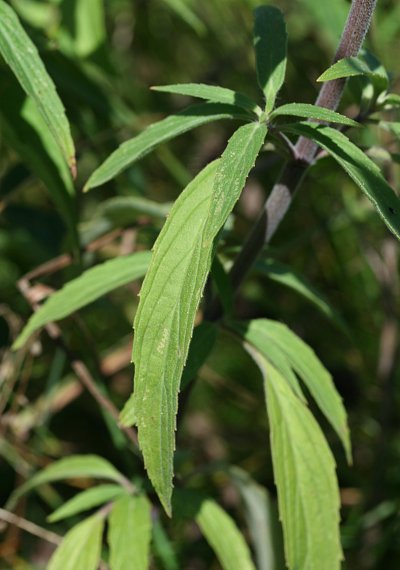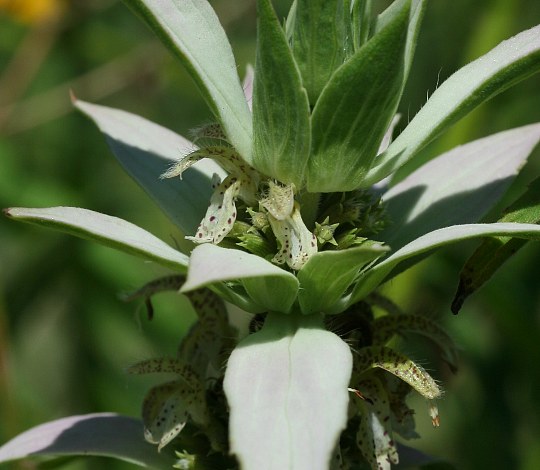Description: This perennial wildflower is 1-3' tall and unbranched or sparingly so, except for short leafy stems that develop from the axils of the leaves along the central stem. It is usually a short-lived perennial, although some plants may persist for only 1 or 2 years. The central stem is brown to reddish purple, 4-angled, and densely pubescent. The opposite leaves are up to 3½" long and 1" across, medium green, and lanceolate to narrowly lanceolate. The margins of the leaves are usually serrated with low teeth, although some of the upper leaves (and bracts) have smooth margins. The central stem produces two or more dense whorls of flowers in the upper portion of each plant. The uppermost whorl of flowers is terminal, while the lower whorls of flowers develop from the axils of the upper pairs of leaves. Each flower is about ¾–1" long, consisting of a cream-colored corolla with purple spots and a tubular calyx with 5 triangular teeth.

The corolla is divided into an upper lip
and a lower lip; they are both long and narrow. The upper lip is keeled
and finely hairy on the top, while the lower lip terminates into 3
small lobes (the middle lobe is the largest of the three). Inside the
corolla near the upper lip, there are 2 long stamens with brown anthers
and a slender style with a divided tip. There are also 2 short stamens
that are sterile. The tubular calyx is green and finely pubescent.
Underneath each whorl of flowers, there are several leafy bracts. The
upper surface of each bract is pink, lavender, or nearly white (in
whole or part). The lower surface of each bract is light green. Aside
from their showy colors and location underneath the flowers, these
bracts are very similar to the leaves. The blooming period occurs from
mid-summer to early fall and lasts about 1-2 months. While individual
corollas soon wither away, the showy bracts remain attractive for a
long time afterward. Each flower is replaced by 4 small nutlets, which
are ovoid and smooth. The root system consists of a taproot. This
wildflower reproduces by reseeding itself.
Cultivation:
The preference is full sun, mesic to dry conditions, and sandy soil.
Spotted Bee Balm has greater tolerance of sun and drought than many
other Monarda spp. (Bee Balms). It is usually
intolerant of competition from taller plants on moist fertile soil,
although it may persist in such areas for several years.

Range &
Habitat:
The native Spotted Bee Balm is occasional in the northern half of
Illinois and the
SW section of the state, but it is rare or absent elsewhere (see Distribution
Map). Habitats include sand prairies, hill prairies, sandy
Black Oak savannas, stabilized sand dunes along Lake Michigan, and
sandy fields. This species can be found in both disturbed and higher
quality sandy habitats. In Illinois, it is rare in non-sandy areas.
Faunal Associations:
The nectar and pollen of the flowers attract honeybees, bumblebees,
Miner bees (Melissodes spp.), and Plasterer bees (Colletes
spp.); butterflies also visit the flowers of Spotted Bee Balm
for nectar, including the endangered Lycaenides melissa
samuelis (Karner Blue), which is found in sandy habitats.
Insects that feed on the flowers, foliage or stems of Spotted Bee Balm
include the caterpillars of the moths Pyrausta orphisalis
(Pyralid Moth sp.), Pyrausta signatalis (Pyralid
Moth sp.), and Agripodes teratophora (The Gray
Marvel); the adults of Strigoderma arboricola
(False Japanese Beetle, or Sandhill Chafer); and both nymphs and adults
of Cydnoides ciliata (Negro Bug sp.) and Sehirus
cinctus (White-Margined Burrower Bug). The oregano-scented
foliage is repugnant to mammalian herbivores and rarely consumed by
them.

Photographic
Location:
A small prairie restoration near a drainage ditch in Urbana, Illinois,
where this species was introduced.
Comments:
Spotted Bee Balm is also called Spotted Horsemint. This species has
rather unusual-looking flowers and attractive bracts. It is easily
distinguished from most Monarda spp. (Bee Balms) in
Illinois by its multiple whorls of flowers on the same stem,
cream-colored and purple-spotted corollas, narrow leaves, and pink to
lavender bracts. The only similar species that can be found in the
state, Monarda citriodora (Lemon Bee Balm;
sometimes referred to as Monarda pectinata), is
native to the Great Plains and rarely escapes from cultivation. This is
an annual species with white to pink corollas that lack spots. The
calyx teeth of Lemon Bee Balm are longer and more pointed than those of
Spotted Bee Balm, which has simple triangular teeth. Different
varieties of Spotted Bee Balm have been described, but they are quite
similar to each other, differing primarily by the kind of pubescence to
be found on the central stem.